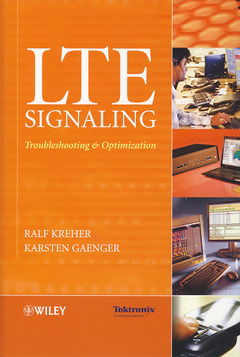LTE signaling troubleshooting and optimization
Auteurs : KREHER, KREHER

A comprehensive reference on the call procedures of 4G RAN and Core networks, LTE Signaling, Troubleshooting and Optimization describes the protocols and procedures of LTE. It explains essential topics from basic performance measurement counters, radio quality and user plane quality to the standards, architecture, objectives and functions of the different interfaces. The first section gives an overview of LTE/EPC network architecture, reference points, protocol stacks, information elements and elementary procedures. The proceeding parts target more advanced topics to cover LTE/EPC signalling and radio quality analysis. This book supplements the information provided in the 3GPP standards by giving readers access to a universal LTE/EPC protocol sequence to ensure they have a clear understanding of the issues involved. It describes the normal signaling procedures as well as explaining how to identify and troubleshoot abnormal network behavior and common failure causes. Enables the reader to understand the signaling procedures and parameters that need to be analyzed when monitoring UMTS networks. Covers the essential facts on signaling procedures by providing first hand information taken from real LTE/EPC traces. A useful reference on the topic, also providing sufficient details for test and measurement experts who need to analyze LTE/EPC signaling procedures and measurements at the most detailed level. Contains a description of LTE air interface monitoring scenarios as well as other key topics up to an advanced level.
Acknowledgments.
1 Standards, Protocols, and Functions.
1.1 LTE Standards and Standard Roadmap.
1.2 LTE Radio Access Network Architecture.
1.3 Network Elements and Functions.
1.3.1 The eNodeB (eNB).
1.3.2 Mobility Management Entity (MME).
1.3.3 Serving Gateway (S-GW).
1.3.4 Packet Data Network Gateway (PDN-GW).
1.3.5 Interfaces and Reference Points.
1.4 Area and Subscriber Identities.
1.4.1 Domains and Strati.
1.4.2 IMSI.
1.4.3 LMSI, TMSI, P-TMSI, M-TMSI, and S-TMSI.
1.4.4 GUTI.
1.4.5 IMEI.
1.4.6 RNTI.
1.4.7 Location Area, Routing Area, Service Area, Tracking Area, Cell Global Identity.
1.4.8 Mapping between Temporary and Area Identities for EUTRANand UTRAN/GERAN-Based Systems.
1.4.9 GSM Base Station Identification.
1.4.10 UTRA Base Station Identification.
1.4.11 Numbering, Addressing, and Identification in the Session Initiation Protocol.
1.4.12 Access Point Name.
1.5 User Equipment.
1.5.1 UE Categories.
1.6 QoS Architecture.
1.7 LTE Security.
1.8 Radio Interface Basics.
1.8.1 Duplex Methods.
1.8.2 Multiple Access Methods.
1.8.3 OFDM Principles and Modulation.
1.8.4 Multiple Access in OFDM - OFDMA.
1.8.5 Resource Blocks.
1.8.6 Downlink Slot Structure.
1.8.7 OFDM Scheduling on LTE DL.
1.8.8 SC-FDMA Principles and Modulation.
1.8.9 Scheduling on LTE UL.
1.8.10 Uplink Slot Structure.
1.8.11 Link Adaptation in LTE.
1.8.12 Physical Channels in LTE.
1.8.13 Transport Channels in LTE.
1.8.14 Channel Mapping and Multiplexing.
1.8.15 Initial UE Radio Access.
1.8.16 UE Random Access.
1.9 LTE Network Protocol Architecture.
1.9.1 Uu - Control/User Plane.
1.9.2 S1 - Control/User Plane.
1.9.3 X2 - User/Control Plane.
1.9.4 S6a - Control Plane.
1.9.5 S3/S4/S5/S8/S10/S11 - Control Plane/User Plane.
1.10 Protocol Functions, Encoding, Basic Messages, and Information Elements.
1.10.1 Ethernet.
1.10.2 Internet Protocol (IPv4/IPv6).
1.10.3 Stream Control Transmission Protocol (SCTP).
1.10.4 Radio Interface Layer 2 Protocols.
1.10.5 Medium Access Control (MAC) Protocol.
1.10.6 Radio Link Control (RLC) Protocol.
1.10.7 Packet Data Convergence Protocol (PDCP).
1.10.8 Radio Resource Control (RRC) Protocol.
1.10.9 Non-Access Stratum (NAS) Protocol.
1.10.10 S1 Application Part (S1AP).
1.10.11 User Datagram Protocol (UDP).
1.10.12 GPRS Tunneling Protocol (GTP).
1.10.13 Transmission Control Protocol (TCP).
1.10.14 Session Initiation Protocol (SIP).
1.10.15 DIAMETER on EPC Interfaces.
2 E-UTRAN/EPC Signaling.
2.1 S1 Setup.
2.1.1 S1 Setup: Message Flow.
2.1.2 S1 Setup: Failure Analysis.
2.2 Initial Attach.
2.2.1 Procedure.
2.3 UE Context Release Requested by eNodeB.
2.3.1 Procedure.
2.4 UE Service Request.
2.4.1 Procedure.
2.5 Dedicated Bearer Setup.
2.6 Inter-eNodeB Handover over X2.
2.6.1 Procedure.
2.7 S1 Handover.
2.7.1 Procedure.
2.8 Dedicated Bearer Release.
2.9 Detach.
2.9.1 Procedure.
2.10 Failure Cases in E-UTRAN and EPC.
3 Radio Interface Signaling Procedures.
3.1 RRC Connection Setup, Attach, and Default Bearer Setup.
3.1.1 Random Access and RRC...
Date de parution : 01-2011
Ouvrage de 282 p.
17x24 cm
Disponible chez l'éditeur (délai d'approvisionnement : 14 jours).
Prix indicatif 104,05 €
Ajouter au panier


